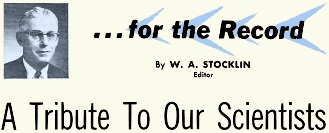|
November 1962 Electronics World
 Table of Contents
Table of Contents
Wax nostalgic about and learn from the history of early electronics. See articles
from
Electronics World, published May 1959
- December 1971. All copyrights hereby acknowledged.
|
The U.S.
Telstar 1 communications
satellite launched atop a Thor-Delta rocket on July 10, 1962. It was the first satellite
to relay television shows and live broadcasts, telephone calls, and telegraph messages
- all analog of course - for both domestic and international purposes. Electronics
World magazine editor W.A. Stocklin used his editorial space in the November
issue to salute the engineers and scientists that made it possible - which includes
all those who paved the way for Telstar I. Planning and development was performed
by a consortium of companies and government agencies.
Bell Telephone Laboratories
built the hardware. AT&T (a
spin-off of Bell
Telephone Company) actually owned Telstar I. Note that in 1962 the unit
prefix "pico" was not in common use, so it mentions micromicrowatts rather than
picowatts. Similarly, publications of the era (and before) used micromicrofarads
(μμF) rather than picofarads (pF).
For the Record - A Tribute to Our Scientists
 By W. A. Stocklin, Editor By W. A. Stocklin, Editor
"Telstar" launched on July 10, has received more public attention than any other
unmanned satellite to date. Even after three months of operation, radio, television,
and the press were still acclaiming this outstanding technical achievement.
We have already seen some samples of transatlantic TV programs and we have been
able to make transatlantic telephone calls. Just the other day, for example, one
of our editors was flying about 5 1/2 miles above eastern Pennsylvania on a new
jet. He was able to sit in on a telephone call made from the plane, to the ground,
then up to "Telstar" several thousand miles away, then down to Goonhilly Downs,
England, and, finally, to an office in London. The London operator came in loud
and clear.
Although the scientists, engineers, and technicians who planned the design and
helped to carry it out were obviously confident of success, many unforeseeable circumstances
could have marred their efforts. On the other hand, to be able to plan, design,
and predict performance, as the engineers and scientists have in this experiment,
would make it seem that luck played only a minor role.
"Telstar's" performance after several hundred orbits remained exactly as planned.
The tracking equipment is so accurate that the satellite's position can be predicted
to within 0.1 degree. And this is possible even though the satellite is a mere yard
in diameter and is radiating a signal which, when picked up at the Andover, Maine,
receiving station, averages only about 7.5 micromicrowatts (0.0000000000075) of
power. Yet voice communications and television transmissions continue to be just
as expected.
These are only a few of the facts, but they do point out a major achievement
and advancement in the field of communications in a few short years.
Although the success at "Telstar" is still being acclaimed, the performance of
our new Venus-bound, spacecraft, "Mariner II," is additional evidence of the "know-how"
of our scientists, engineers, and technicians. Extremely difficult space maneuvers,
at a great distance from the earth, were accomplished on September 4, when this
spacecraft's direction was changed.
Original plans were to have "Mariner II," a 12-foot, 450-lb. space vehicle, pass
within 10,000 miles of the planet Venus. Unfortunately, during lift-off, the "flying
laboratory" was projected in such a course that it would have crossed the orbit
of Venus some 233,000 miles ahead of the planet. At this distance few useful observations
could have been made. But nine days after launching, and after the spacecraft had
traveled approximately 1.5 million miles, scientists at California Institute of
Technology's Goldstone tracking station in California's Mojave Desert decided to
attempt to correct its course. By ground radio command, the spacecraft was made
to roll on its axis and pitch forward so that it was in the proper position for
rocket firing. Next, the rocket fired, slowing down the vehicle and altering its
course. Finally, the long-range precision antenna was re-oriented toward earth and
the panels of solar cells were pointed toward the sun. Predictions now are that
"Mariner II" will pass within 9000 miles of Venus.
On the day after this complex maneuver was successfully completed, scientists
were still getting "loud and clear" signals from the spacecraft's 3-watt transmitter
when it was nearly 2 million miles from earth. They expect to be able to track it
even beyond the planet Venus.
It is hoped that a Venus pass will provide us with details on the planet's temperature
and type of atmosphere, along with details on magnetic and radiation fields. Obviously,
all of these facts will help us determine whether life, as we know it, can exist
on the distant planet.
Considering that Venus will be about 36 million miles from earth at the time
"Mariner II" is due to pass it around noon (EST) on December 14 there should be
no doubt in anyone's mind that the entire project is an outstanding scientific achievement.
Honors are due not only to the brilliant scientists who conceived these systems,
but also to the many engineers and technicians who carried out the designs.
Posted October 26, 2022
|









 By W. A. Stocklin, Editor
By W. A. Stocklin, Editor 
